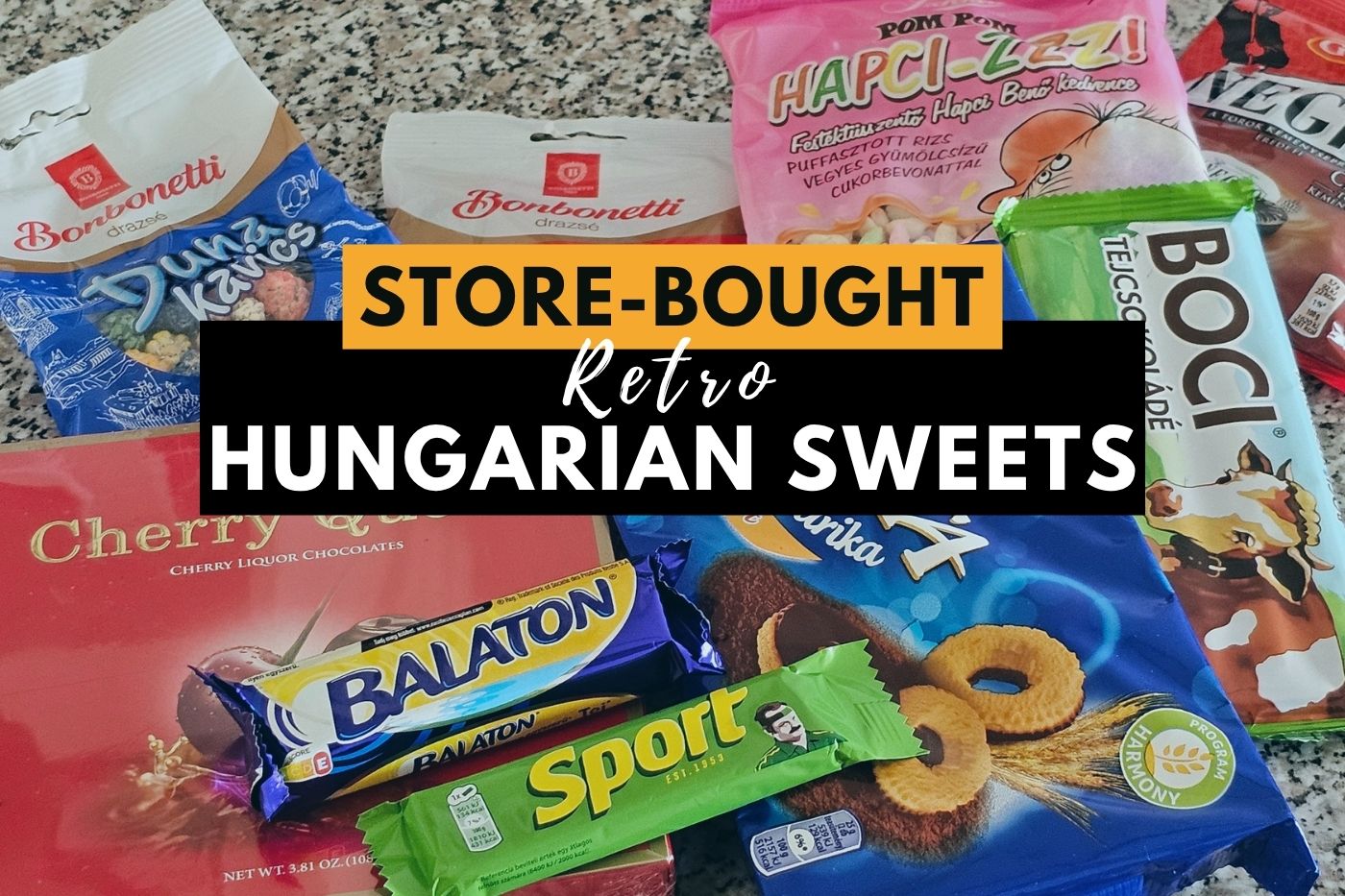13 Classic Hungarian Sweets We Grew Up With And Still Eat Today
If you’ve ever been curious about classic Hungarian sweets but didn’t know where to start, you will love this list. These are the kinds of treats I grew up with and still enjoy today, because luckily, you still find them in supermarkets, corner shops, or grandma’s cupboard.
From the must-try Túró Rudi to our traditional Sport Chocolate Bar and Pilot Cookies, here are some of my personal favorite store-bought Hungarian sweets that are absolutely worth a try. Best part? They are all affordable too, costing just a few hundred Forints (€0.5-2) per piece or €5-8 if it is a package. Let’s get started and snack on some Hungarian goodies!
Here is a quick list you can save and maybe use when shopping for some sweet snacks:
Must-Try:
Túró Rudi: Chocolate-covered curd snack
Pilóta Keksz: Bite-sized sandwich cookies with rich cocoa filling
Boci Csoki: Creamy milk chocolate bar
Highly recommended:
Sport Szelet: Rum-flavored chocolate bar
Balaton Szelet: Crispy wafer bar coated in chocolate
Vaníliás Karika: Vanilla ring cookies half-dipped in chocolate.
Dunakavics: Candy-coated roasted peanut
Francia Drazsé: Sugar-coated chocolate dragees
Macskanyelv: Cat tongue-shaped milk chocolate pieces
Szamos Szívdesszert: Heart-shaped marzipan pralines
Konyakmeggy: Sour cherry soaked in brandy, wrapped in rich dark chocolate
Zizi: Puffed rice with sugar coating
Negro Cukor: Anise-menthol flavored black lozenge
Scroll down for details, descriptions, and a few personal stories!
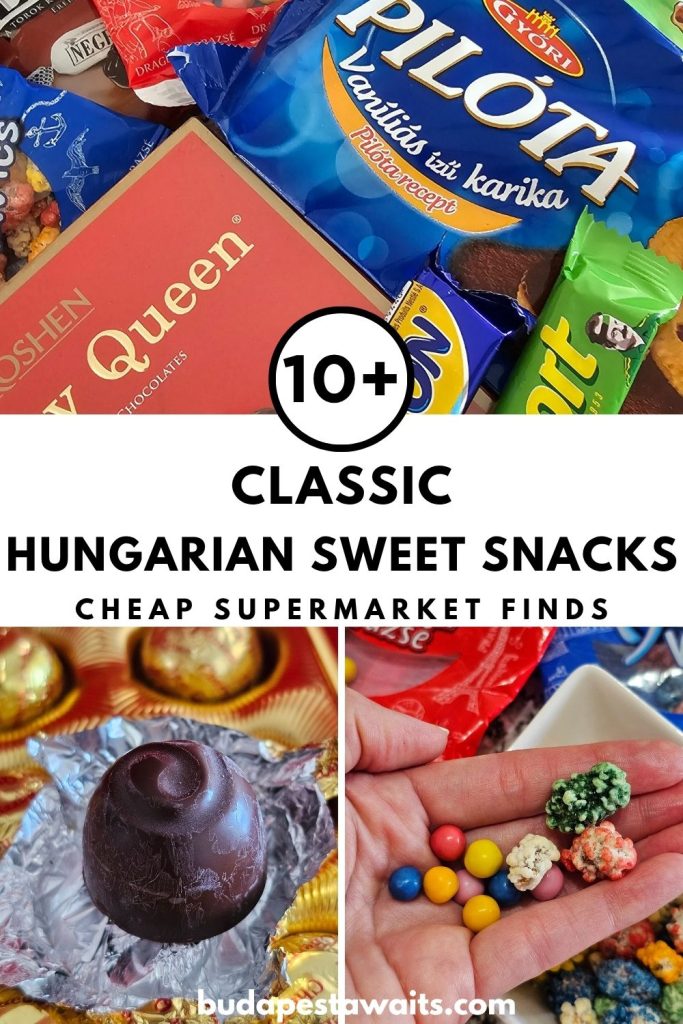
Affordable Store-Bought Hungarian Snacks, Chocolates, Cookies and Candies
Túró Rudi: Chocolate Coated Curd Bar
You simply can’t visit Budapest without trying our popular sweet snack, Túró Rudi. This nostalgic Hungarian treat is made from sweetened curd (similar to cottage cheese but milder and dessert-like) covered in a thin layer of chocolate.
The base of túró rudi, curd, is only produced in Eastern and Central Europe, making this treat quite unique to this region. We eat it as a dessert and even as a snack whenever we crave something sweet. One piece costs about 200-300 Ft (€0.5-0.8), depending on the brand and the size.
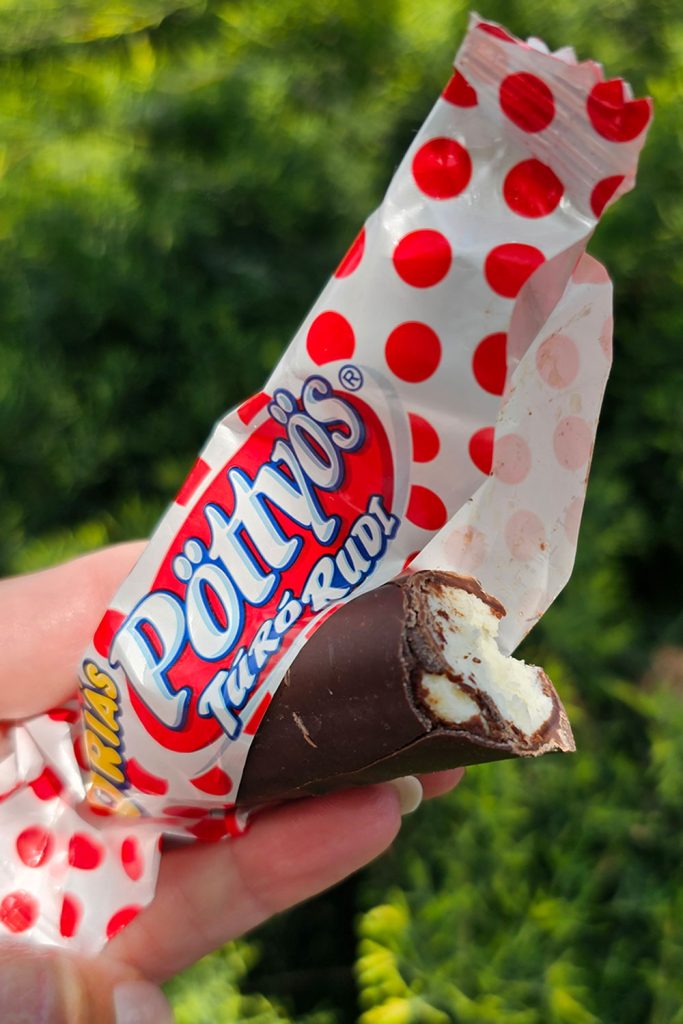
Since this sweet treat is dairy-based, you will find it in the fridge, usually near yogurts and cheeses. The original and most well-known version is the Pöttyös Túró Rudi. Pöttyös means dotted, referring to the red dots on the packaging.
It’s available in most supermarkets and comes in several variations, including lactose-free and flavored ones (the new pistachio variety is very popular this year). I recommend starting with the original: dark chocolate coating and no filling.
Personally, my favorite is Cserpes Trudi. It has a creamier curd filling and richer dark chocolate coating. You can usually find it in Aldi stores; less common than Pöttyös, but still easy to locate.
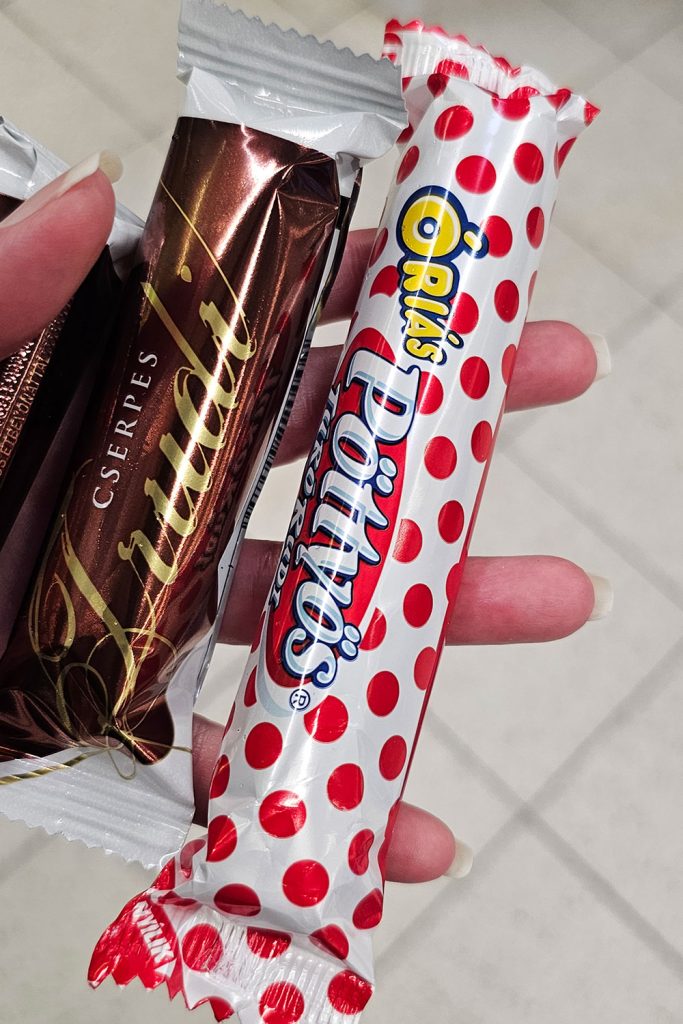
Pilóta Keksz – Pilot Cookies
Pilóta Keksz is one of those classic Hungarian cookies that’s been around for generations. It’s made of two cookies, one cocoa and one vanilla, sandwiched together with a cocoa-flavored cream filling; the perfect mix of crunchy and creamy.
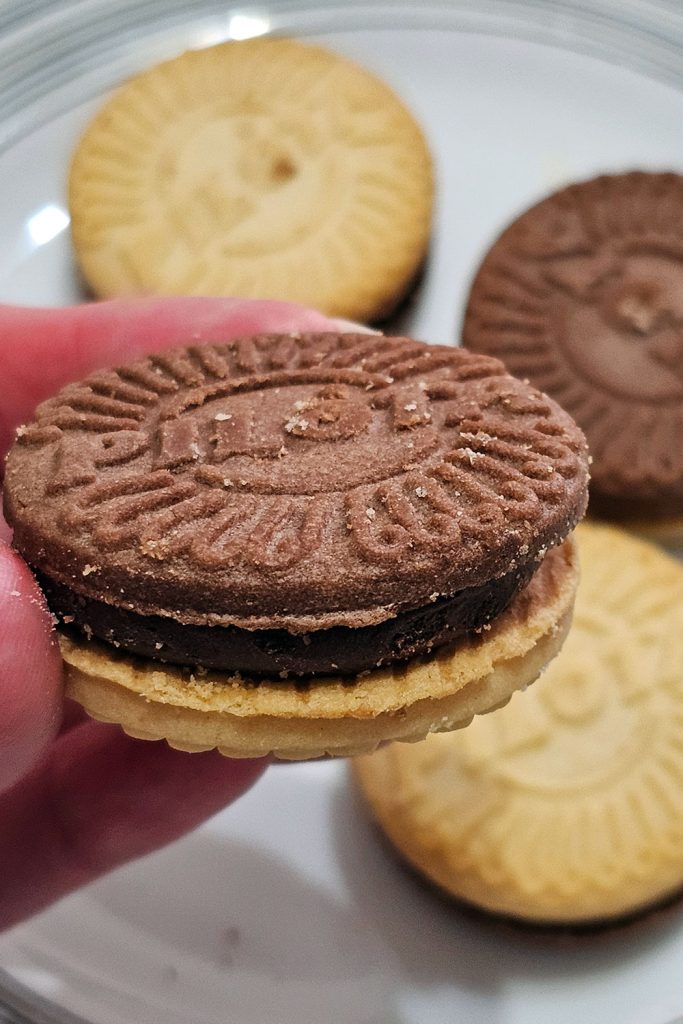
You’ll find it in pretty much every supermarket. It’s great with tea or coffee, or just as a quick snack when you’re craving something sweet but not over-the-top. As a kid, I loved twisting them apart to lick the filling – still do, actually.
Over the years, they’ve brought out other versions, like with lemon or coconut filling, but only the original and full-chocolate variations (when both cookies and also the cream are cocoa-flavored) are sold continuously.
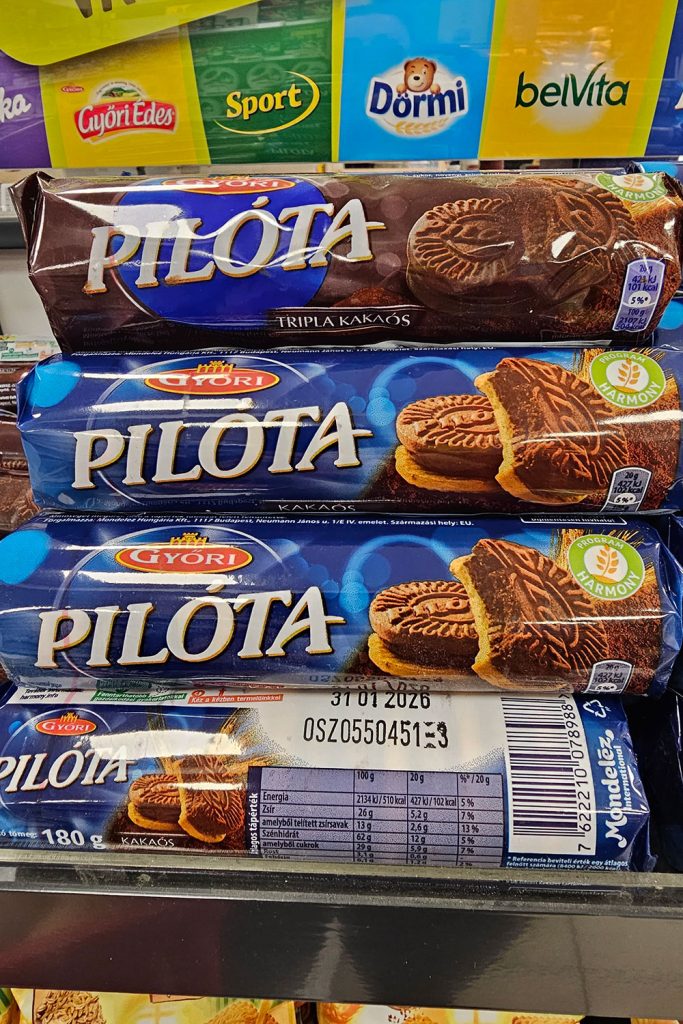
They’ve changed the recipe over the years. The taste isn’t quite what it used to be, but the cookie still holds a place in our hearts. A 180-gram package costs around 800 Ft (€2).
Boci Csoki: Boci Chocolate Bar
Nothing reminds me of childhood quite like Boci Csoki. It was my and many people’s first chocolate bar, so it is deeply nostalgic for us.
The classic version is plain milk chocolate with a soft, creamy texture. It now comes in several flavors, but I still prefer the original.
The apricot-cookie one was amazing, but sadly it was discontinued (why???) and is only available in specific promotional periods. If you see this version, don’t hesitate to get one; otherwise, stick to the basic plain milk chocolate.
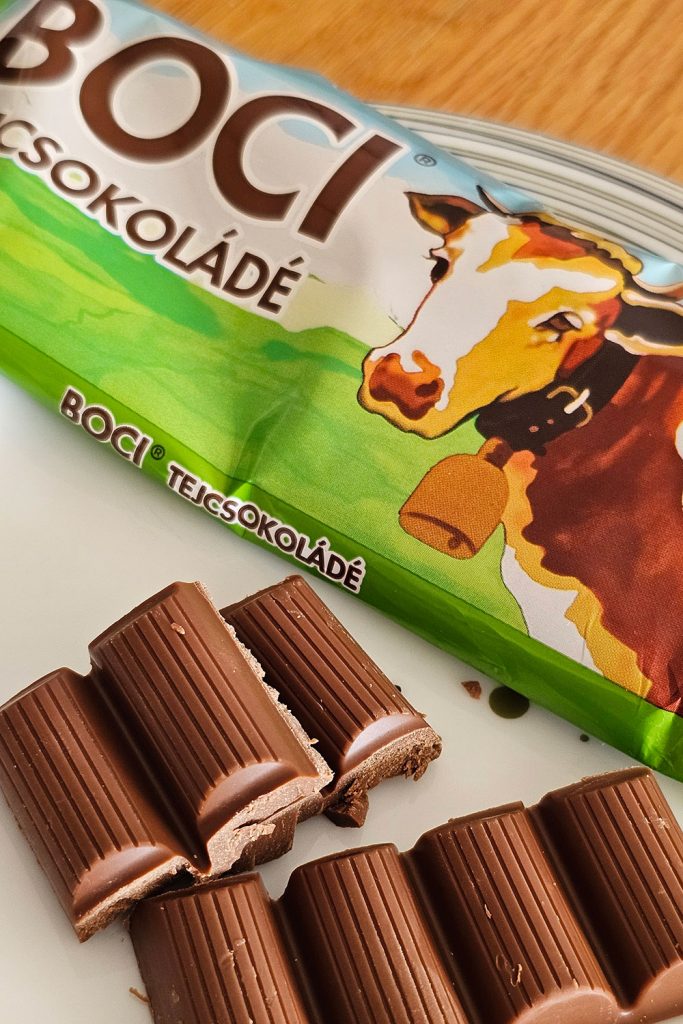
“Boci” means “calf,” and the classic packaging shows a cartoon cow. My German friends once joked it’s like the Hungarian Milka, which gave us all a good laugh.
The brand went through many changes over the years, and now it is part of Nestlé, but luckily, this chocolate managed to keep its Hungarian branding and identity. It is still affordable (a 90-gram bar costs about 600-800 Ft, €1.5-2) and widely available in supermarkets, kiosks, and even gas stations.
Sport Szelet: Sport Chocolate Bar
Ask any Hungarian over 40 about their favorite childhood chocolate, and Sport Szelet will likely come up. It debuted in 1953 to mark the opening of Népstadion, Hungary’s largest stadium.
It has a distinctive taste: a cocoa and rum-flavored filling covered with a thin layer of dark chocolate. Despite the rum flavor, it’s non-alcoholic. I like it because it’s not too sweet.
Originally, Sport Szelet was sold as a 25-gram bar wrapped in aluminum foil and a distinctive green paper featuring an image of discus thrower József Szécsényi. While the original version has been retired (citing the non-sustainable nature of its aluminum foil packaging), larger and updated versions, including new flavors like coconut and white chocolate, continue to be available.
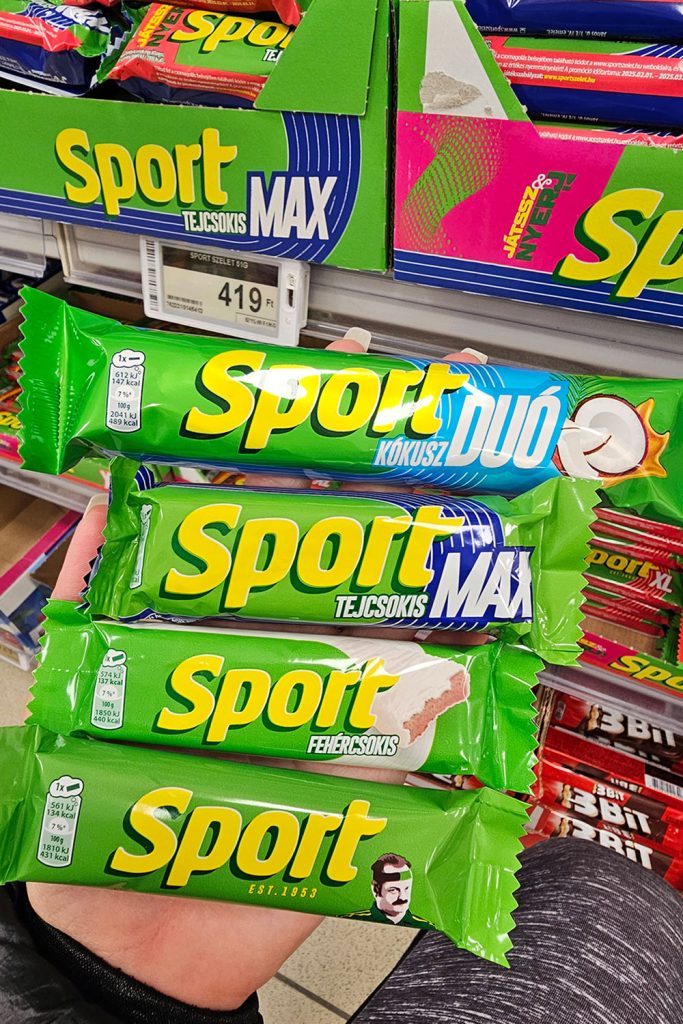
To be honest, I didn’t try the new flavors, only the coffee one, which is called Sport Kapucíner, filled with a coffee-inspired cream, today’s version of another well-known socialist era Hungarian chocolate treat.
A typical bar costs about 250-350 Ft (€0.7–0.8).
Balaton Szelet: Balaton Wafer Bar
Everyone knows Balaton Szelet in Hungary. It’s a simple layered wafer bar coated in chocolate. Crunchy, sweet, and super nostalgic.
It’s named after Lake Balaton, Hungary’s beloved summer vacation spot. Just hearing the name makes people think of childhood holidays, ice cream, and lazy days.
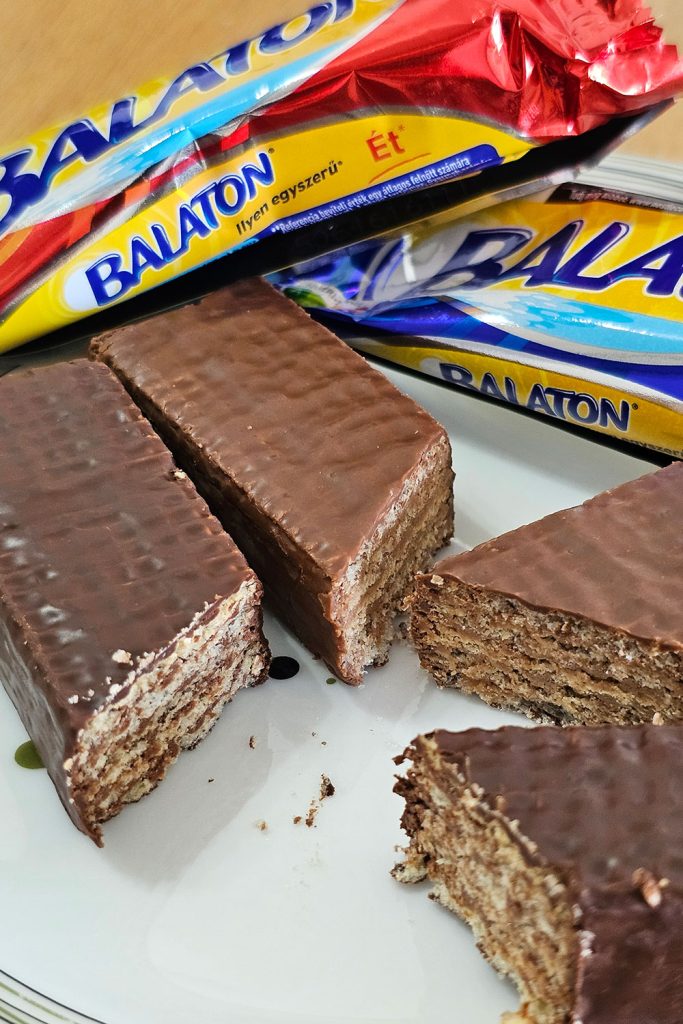
Flavors like lemon and coconut exist, but I always go back to the original. It’s very affordable, 200-250 Ft (€0.5–0.6), even at the airport, where it costs around €1 (you can get in the Memories of Hungary Store).
Vaníliás Karika: Vanilla Ring
There’s something quietly iconic about Vaníliás karika. This no-cream, no-filling, simple vanilla cookies half-covered in chocolate glaze has always been in our cupboards.
It’s the kind of treat you don’t necessarily crave, but once you open a pack, you somehow eat five without realizing. A 150g pack usually costs 800-1,000 Ft, (€2–2.5).
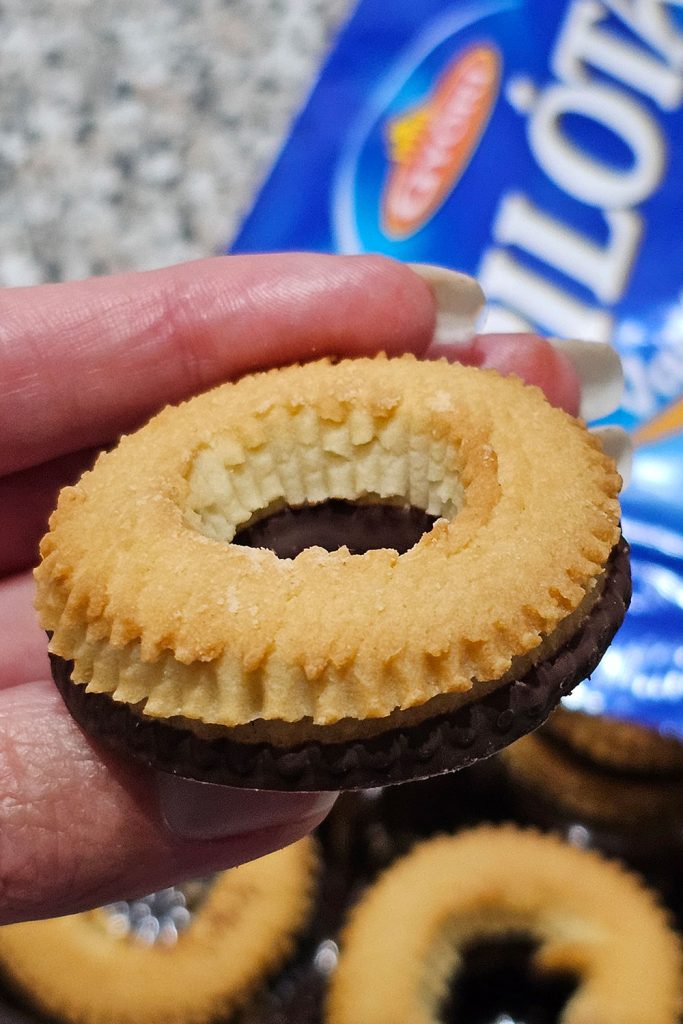
For us, Vaníliás karika has always been a must at every family lunch or dinner. It wasn’t even a question; my grandpa would always bring a pack as dessert, no matter the occasion. It became his thing.
He’s gone now, but someone still brings it to the table. It’s just one of those small traditions that stay with you.
Dunakavics: Danube Rock Candies
Dunakavics is a really fun, simple treat, one of the most interesting finds among traditional Hungarian store-bought sweets. They’re roasted peanuts covered in a crunchy, colorful sugar shell, kind of like small colorful rocks.
This actually fits the name since Dunakavics means “Danube rock or Danube pebbles.” (The Danube is the river that flows through Budapest and the whole of Hungary, and is a huge part of the country’s landscape and culture.)
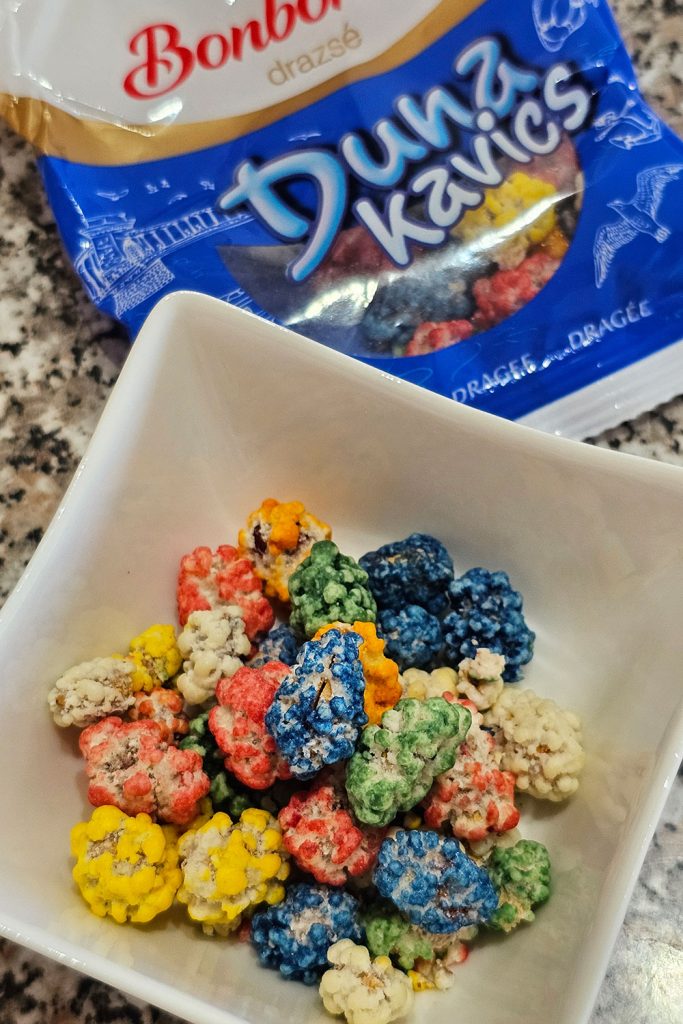
What’s cool about them is the taste: it’s kind of unexpected because peanuts are usually salty, right? But these are sweet, which makes for an interesting combo that’s surprisingly addictive.
Dunakavics is perfect for snacking anytime. You can pop a handful in your mouth, and before you know it, the whole bag is gone!
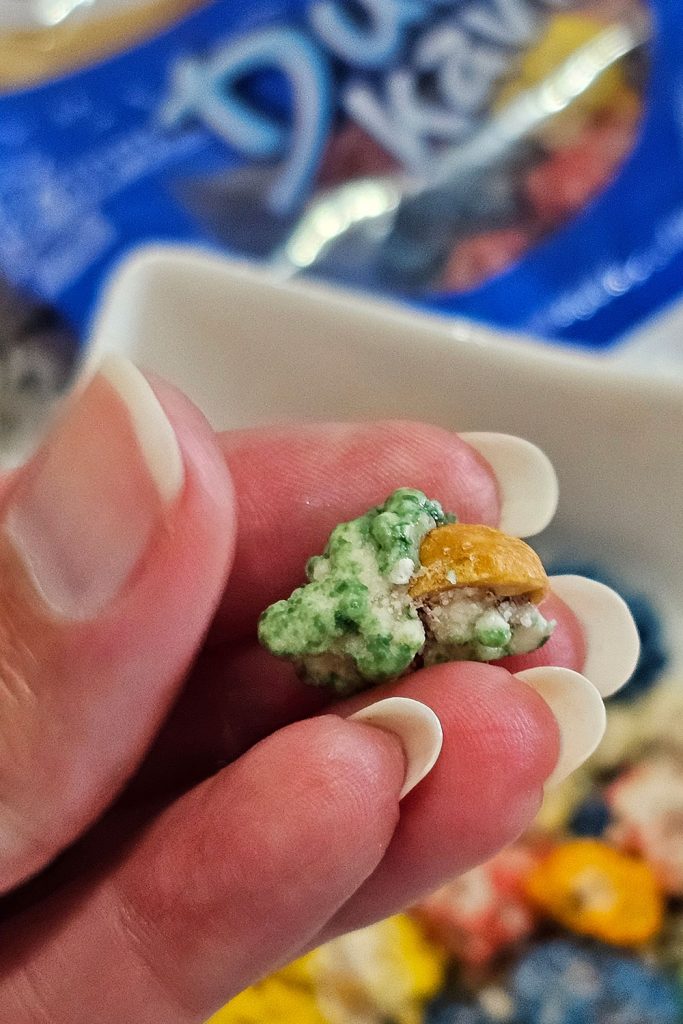
Francia Drazsé: French Dragee
Not a fan of peanuts? Try Francia Drazsé. These are pastel-colored chocolate balls with a crisp sugar shell. You bite in, and they melt in your mouth. Perfect for when you need a mini pick-me-up between sightseeing stops!
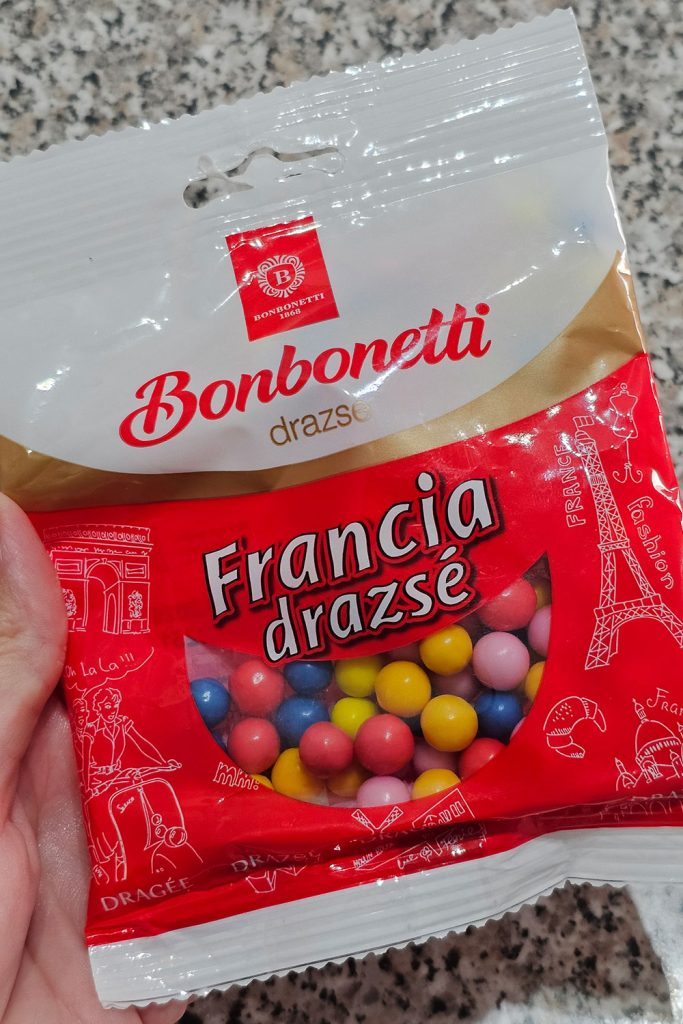
Both Dunakavics and French Dragee come in 70g packs and typically cost around 400 Ft (about €1), making them a fun and affordable nostalgic treat.
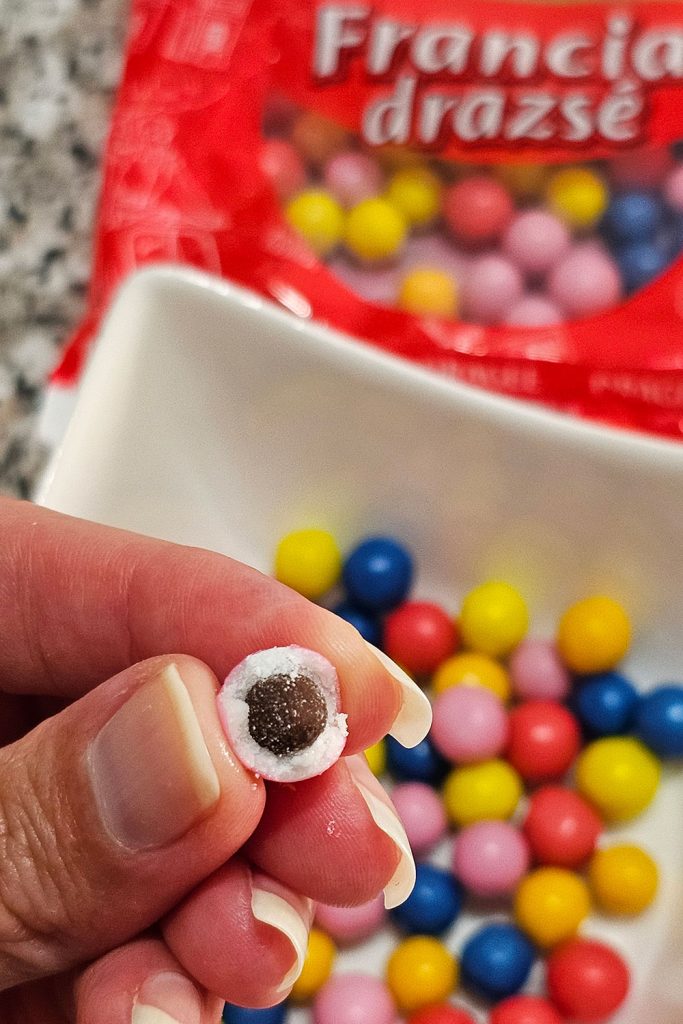
Macskanyelv: Cat’s Tongue
Yes, the name is odd. But Macskanyelv is one of our classic chocolates, shaped like a cat’s tongue. Thin pieces of chocolate come in decorative boxes, making them a popular gift.
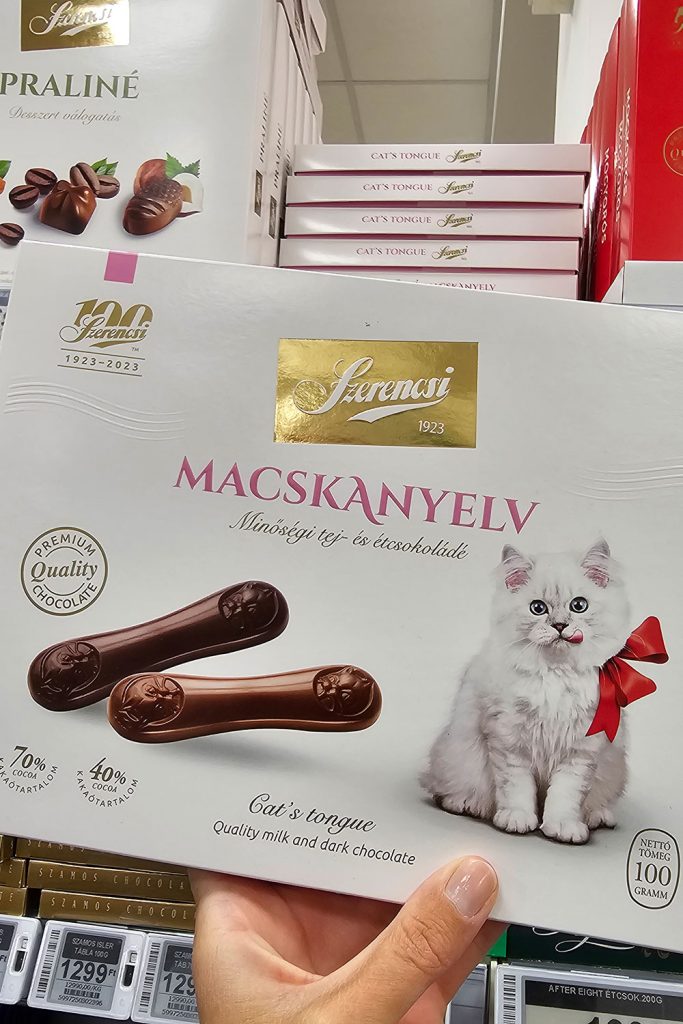
Usually, cat’s tongue is milk or dark chocolate, but you can find white chocolate versions and even filled ones. You’ll find it from well-known Hungarian confectionery brands like Stühmer and Szerencsi.
Last time I was at the airport I found a fancy filled selection from Gerbeaud in the duty free shop. The 64g box was almost €20, which I found expensive, so I didn’t buy it; however, it looked delicious! The classic supermarket versions are ~2,500-3,200 Ft (€6–10).
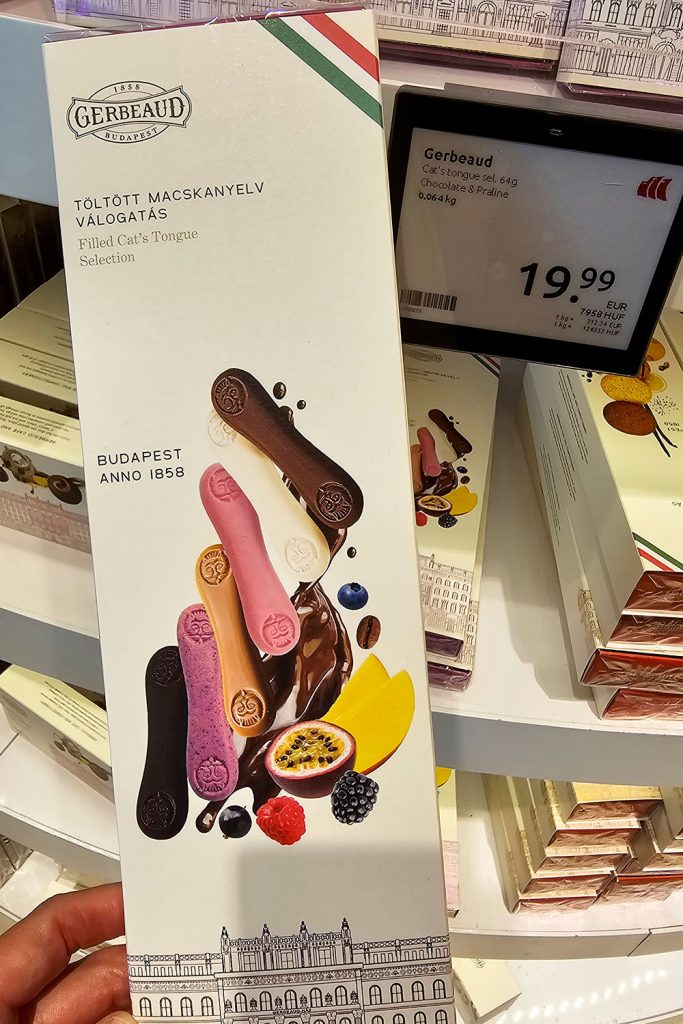
Szamos Szívdesszert: Szamos Heart Dessert
In high school, you weren’t a cool girl unless you got a Szamos Heart for Valentine’s Day. Boys gave them to girls they liked, and we always waited to see who would get one; what a sweet and subtle way to express feelings!
These heart-shaped marzipan praline bites are produced by Szamos Marcipán, which is still one of Hungary’s most prestigious and beloved confectionery brands. The pralines made with high-quality ingredients like premium marzipan, hazelnut cream, chocolate, or fruit-flavored fillings.
Szívdesszert is sold in decorative gift boxes, making it a perfect gift to take home from Hungary to your loved one! It usually costs around 3,200 Ft (approximately €8.25). Small shops often sell it individually, too, usually near checkouts.
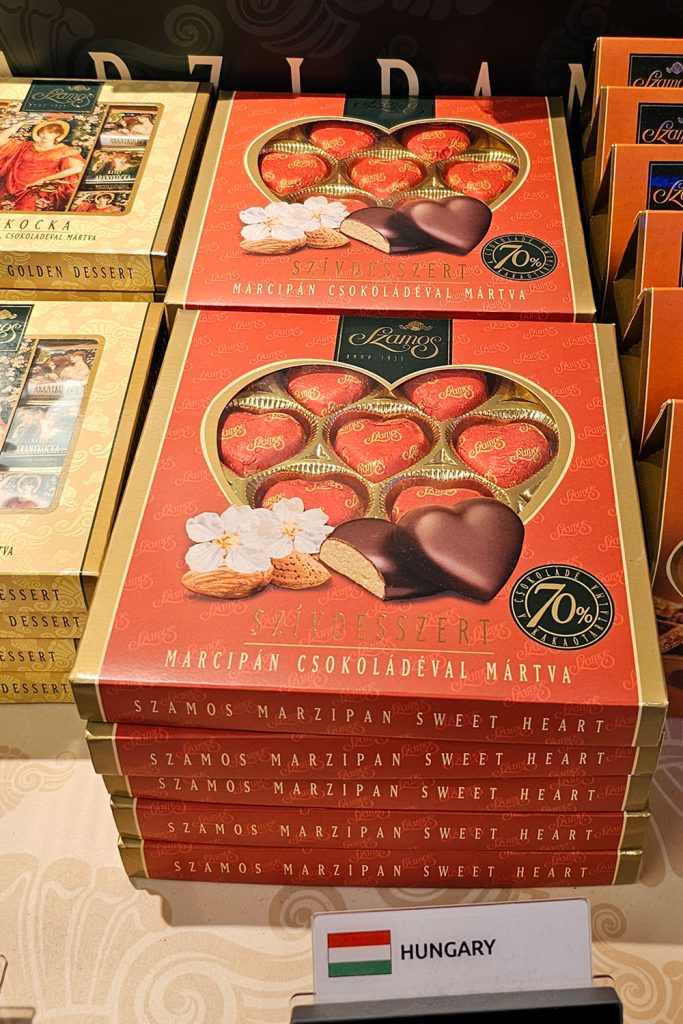
Konyakmeggy: Cognac Cherry
Want something more intense? Try Konyakmeggy, a whole sour cherry soaked in brandy or cognac, coated in sugar syrup and dark chocolate.
This treat used to feel like a luxury. It came in shiny wrappers and was often a birthday or holiday gift. It was a grown-up chocolate (due to its alcohol content), but my siblings and I would sneak a few when the adults weren’t looking. Psst… don’t tell my parents!
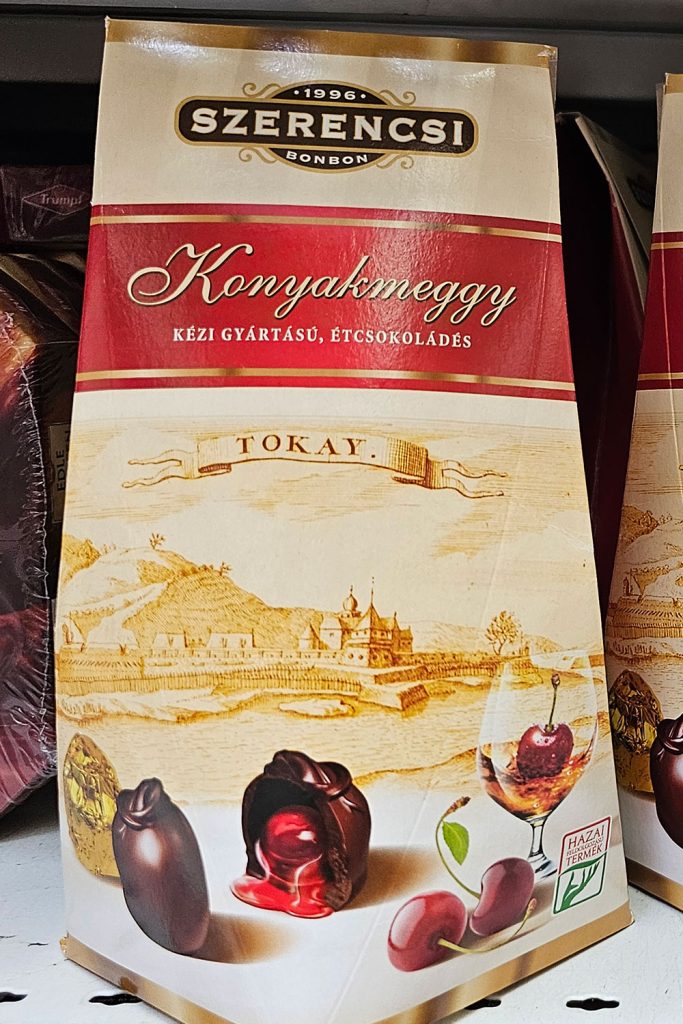
You can find cheaper Konyakmeggy for around 1,500 Ft (~€4) , but honestly, they’re usually disappointing. If you want the real deal, go for a quality brand like Szerencsi. It’s a bit more expensive, around 5,000 Ft (€12.5), but totally worth it for the proper chocolate and cherry flavor.
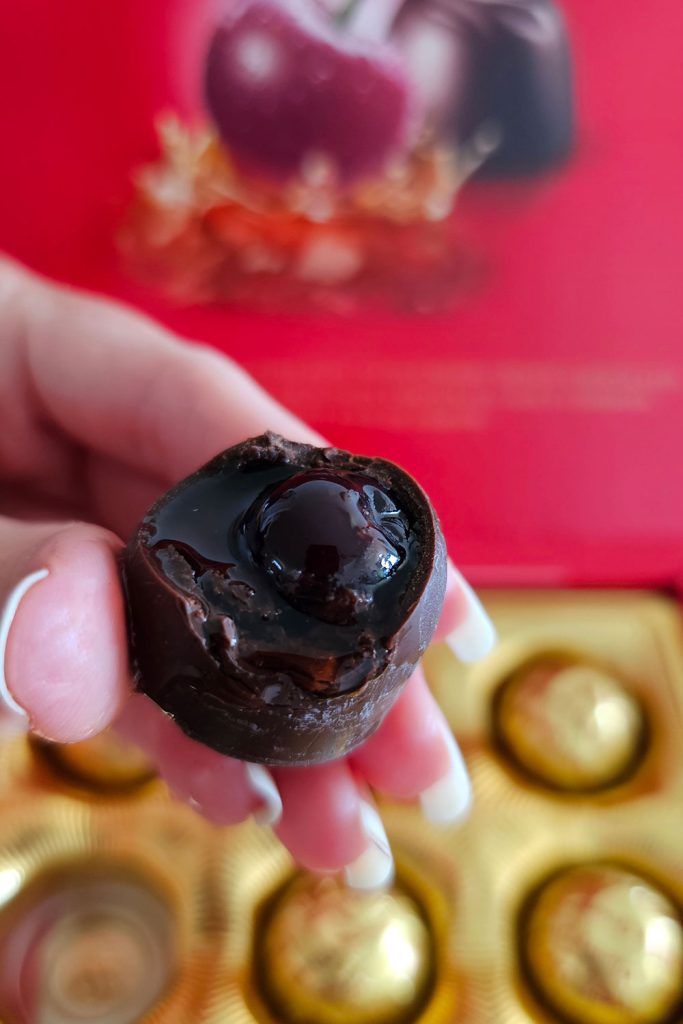
Zizi: Puffed Rice Candy
Zizi is a colorful puffed rice candy. It might look like a diet snack at first glance, but it’s really just sugar-coated puffed rice.
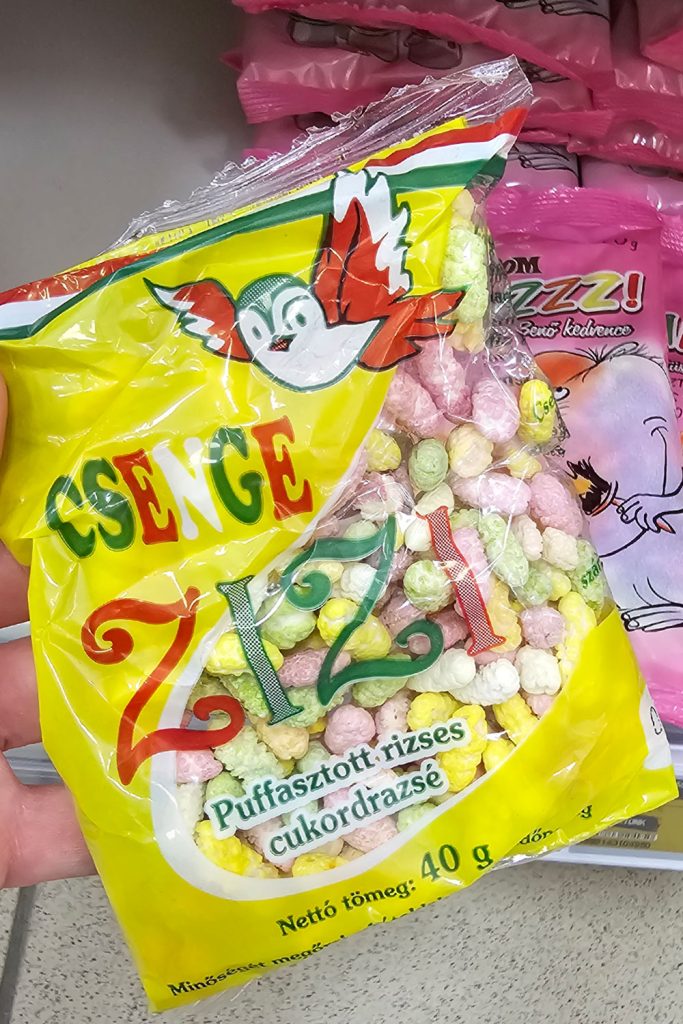
It comes in fun pastel colors. We used to buy it at school or on class trips. I always saved the pink ones for last, even though they all tasted the same.
Even now, when I see it in shops, I can’t help but grab a bag. It’s crunchy, full of nostalgia and cheap (you’ll get it around €1). If you’re in Hungary and spot it, give it a try.
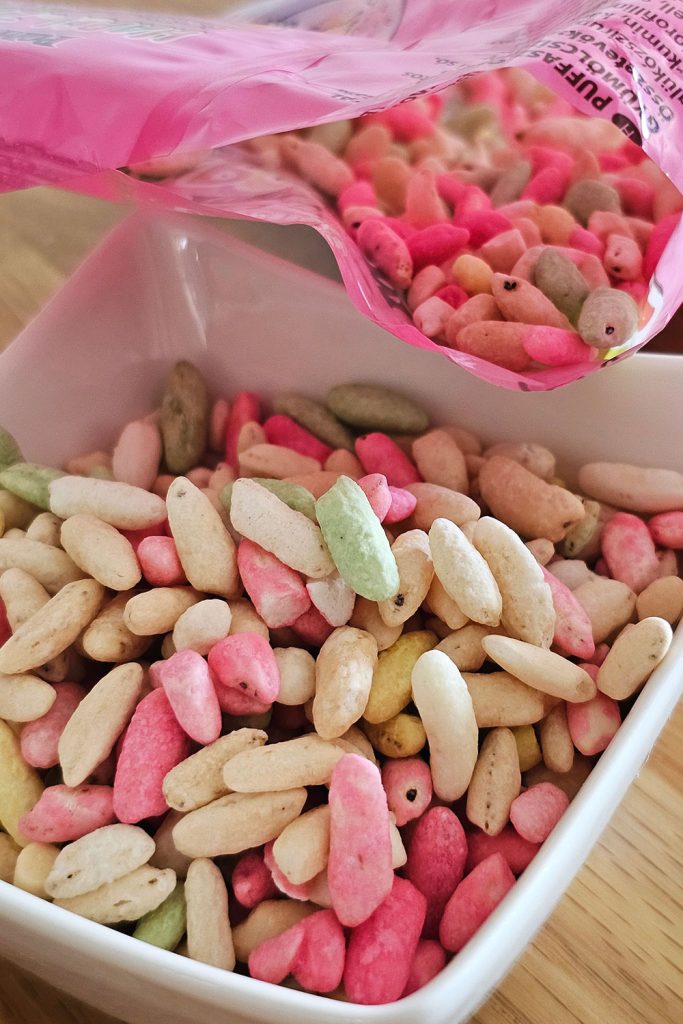
Negro Candy
Sore throat? Negro is our secret remedy! It’s a black lozenge with a strong anise-menthol taste, it’s like Ricola meets black licorice.
We call it the “chimney sweep of the throat because it helps soothe coughs, open sinuses, and clear the throat. We often call it the “chimney sweep of the throat”.
Some people find it too herbal, but it works wonders. In my opinion, it is more effective than those fancy throat soothers you can buy at a much higher price, so give it a chance! And you don’t need to be sick to enjoy it; it’s refreshing and unique. A 79g pack of Negro Classic candy is available for approximately €1.
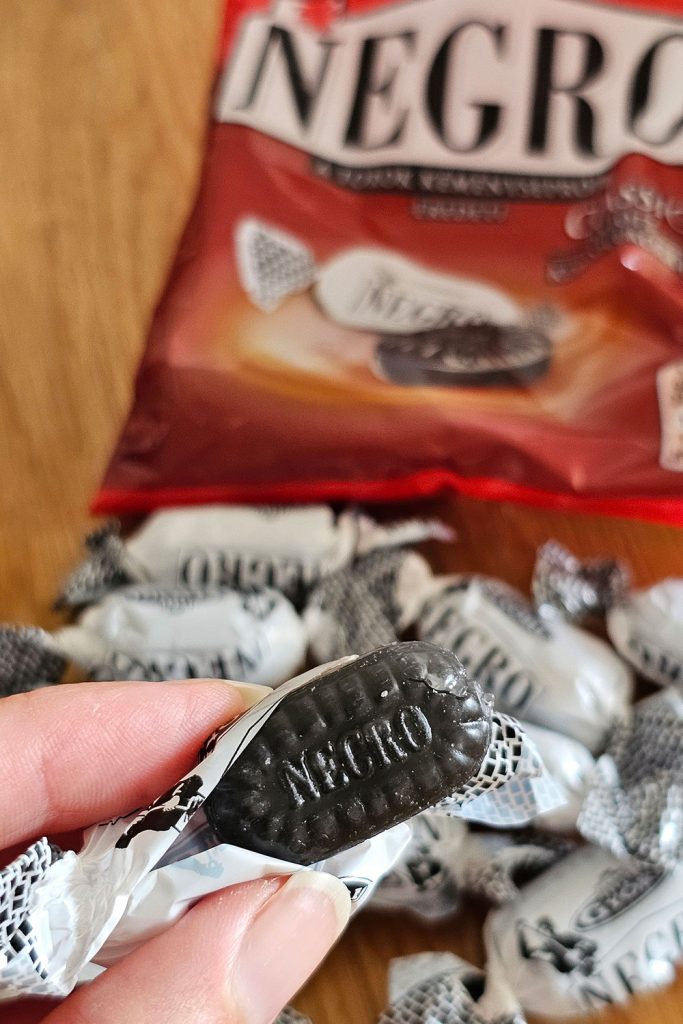
Why You Should Try Some of These Classic Hungarian Sweets?
For us, these sweets are packed with nostalgia. We grew up with them, and they still bring back good memories. I still buy them instead of newer, overly sweet snacks and here are a few reasons why you should also try them.
You Can Taste Hungarian History
They offer more than a quick sugar fix; eating these treats is an invitation to taste a piece of the country’s cultural and culinary heritage. Many of them are tied to historical events or family traditions.
You Can Try Unique Flavors
Hungarian retro chocolates, cookies and candies use flavors not often found elsewhere, like rum, marzipan, anise, or brandy-soaked fruit.
They make cheap and easy souvenirs
These treats I listed above are affordable, widely available in supermarkets and corner shops, and small enough to bring home. Coop, the country’s largest grocery‐store network, offers the widest selection of classic Hungarian treats. You can use their shop finder to locate the nearest one when in Budapest.
Plus, most of them you can buy at BUD airport too. Some are available in the Heinemann Duty Free Store. The Memories of Hungary shop (on the left after security control and the Heinemann main store) offers an extended selection of Hungarian products. But, expect to pay 2–3x more than in the city.
They Connect You With Locals
Local Hungarians love talking about these treats. Mention Túró Rudi and you might end up chatting with locals in the snack aisle or maybe even making new friends, like it happened to me!
Once, I helped a Korean couple in a Budapest supermarket pick out a Túró Rudi. They were standing in front of the fridge, looking at the different products and trying to figure out the difference between them.
It is not easy if you don’t have your phone with you to translate the text on the packaging, as on most local items, everything is written in Hungarian only.
Long story short, they really liked the Túró Rudi, asked me to recommend more traditional sweets and I even showed them a nearby place to try our famous chimney cake (Kürtős Kalács).
Ultimately, we exchanged contact details, and they offered me their help if I visited Korea. That’s the kind of connection food can spark!
You Will Have An Offbeat Local Experience
Everyone wants to eat goulash and drink palinka (don’t get me wrong, you absolutely need to try our delicious dishes and spirits when you are visiting Hungary) but only a few discover the charm of our retro treats. It’s an offbeat, authentic way to experience more of Hungary.
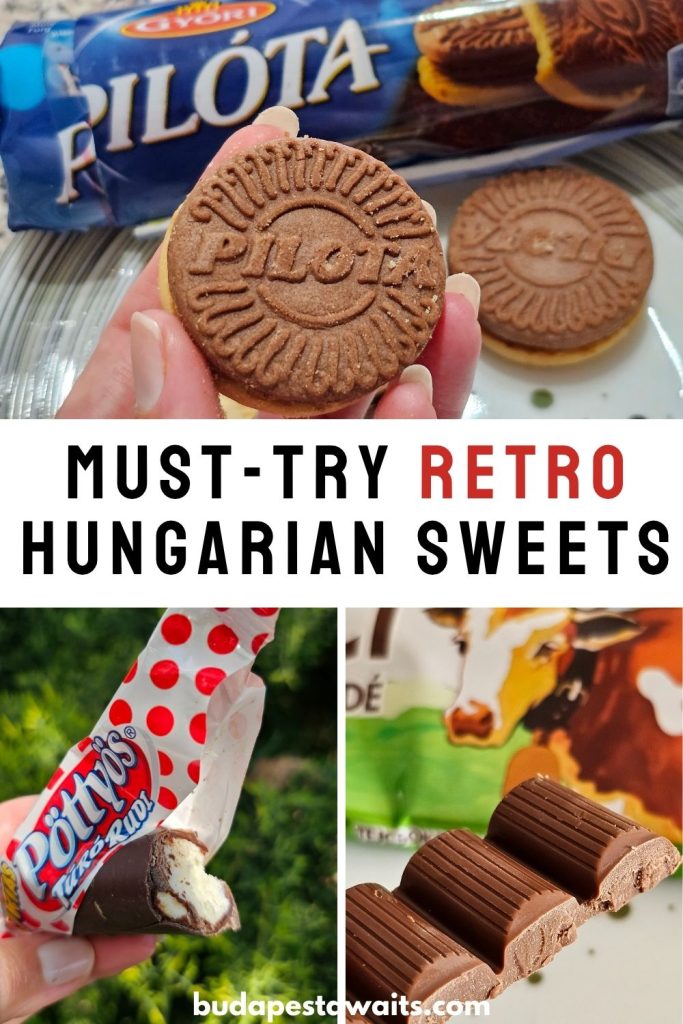
Hungary has no shortage of sweet treats. This list is just a taste of what’s out there. I focused on affordable, easy-to-find items, but there’s plenty more to explore (like our amazing desserts and cakes). Think of these sweets as edible souvenirs — nostalgic, unique, and full of character.
Have you tried any of these? Which one was your favorite? Share your thoughts or stories in the comments! If you enjoyed this guide, consider subscribing or sharing it with a fellow foodie or traveler!
Prices are approximate and valid at the time of writing. They may vary by store, location, or promotions. In Hungary, prices are listed in forints (Ft), so you’ll be paying in the local currency. Card payments are widely accepted these days, but cash is still an option if you’ve exchanged money.
